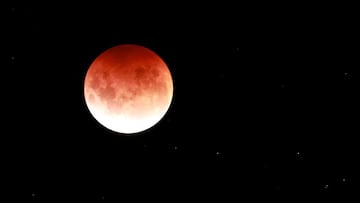How often does a Super Flower Blood Moon happen?
Tonight an unusually large red moon will take over the night sky, thanks to a combination of lunar events occuring at the same point in the moon’s cycle.

On Sunday night, star-gazers across the planet will be treated to a lunar spectacle known as a Super Flower Blood Moon, lighting up the night sky with an eclipse.
But what actually is it, and how often does it occur? The slightly convoluted name can be split into constituent parts to give a better idea of exactly what we’re talking about here.
A ‘super’ moon occurs when the moon’s uneven orbit brings it particularly close to the earth, making it appear larger than normal in the sky. In the northern hemisphere a full moon that occurs in the spring is sometimes referred to as a ‘flower’ moon, because the event coincides with the blooming of many types of flowers. Finally, a ‘blood’ moon refers to the unusual red colouring as a lunar eclipse causes the earth to block the sun from the moon, changing the colour as viewed from earth.
How rare is a Super Flower Blood Moon?
Given that a Super Flower Blood Moon is a combination of unusual characteristics, the exact conditions required for such an event do not come around very often. Another flower moon will not occur until next spring, as we head into the summer months.
Lunar eclipses, the phenomenon that causes the red ‘blood moon’ colouring, happen about three times a year on average, but do not always line up with the full moon in spring.
Supermoons are based on the undulating orbit of the moon in relation to the earth, and happen at a rate that appears almost entirely random. On average there are around four supermoons in a year but they often happen in batches. Sunday’s supermoon will be the first of four consecutive months with the lunar spectacle.
All that means that we can’t expect another Super Flower Blood Moon for the remainder of 2022, and possibly a lot longer.
What is a supermoon?
Although this weekend’s event is accepted to be a supermoon, there is some dispute about the exact definition. The earliest definition of a supermoon comes from astrologer Richard Nolle who, in 1979, defined it as a full moon that comes within 90% of its closest point in the orbit to Earth.
Epsenak’s definition of supermoon fits the next four full moons: 16 May, 14 June, 13 July and 12 August. Given the orbital routine of the moon, this type of pattern is not particularly rare. Epsenak’s website says that 2023 will also see four consecutive supermoons, as will 2024.






